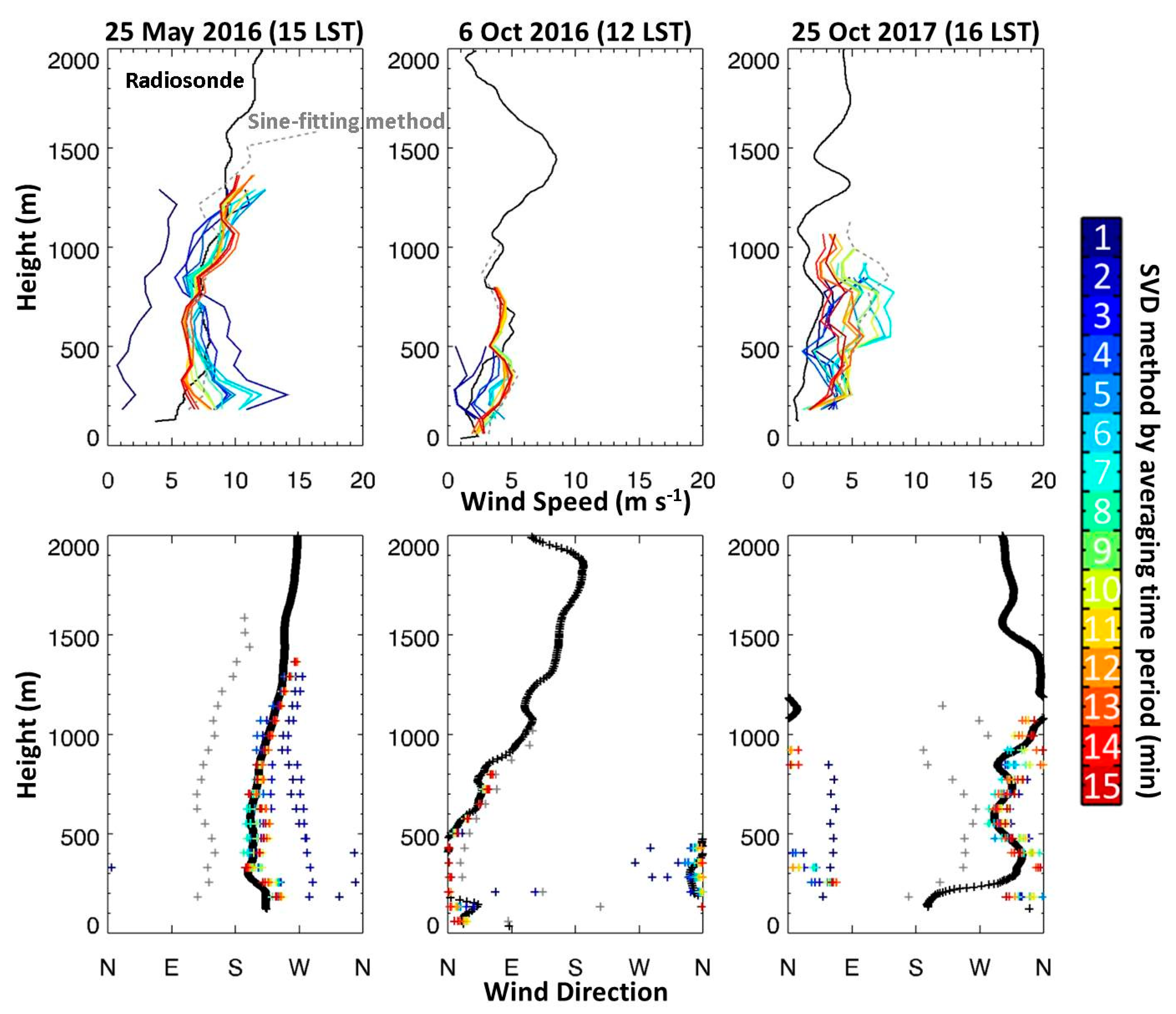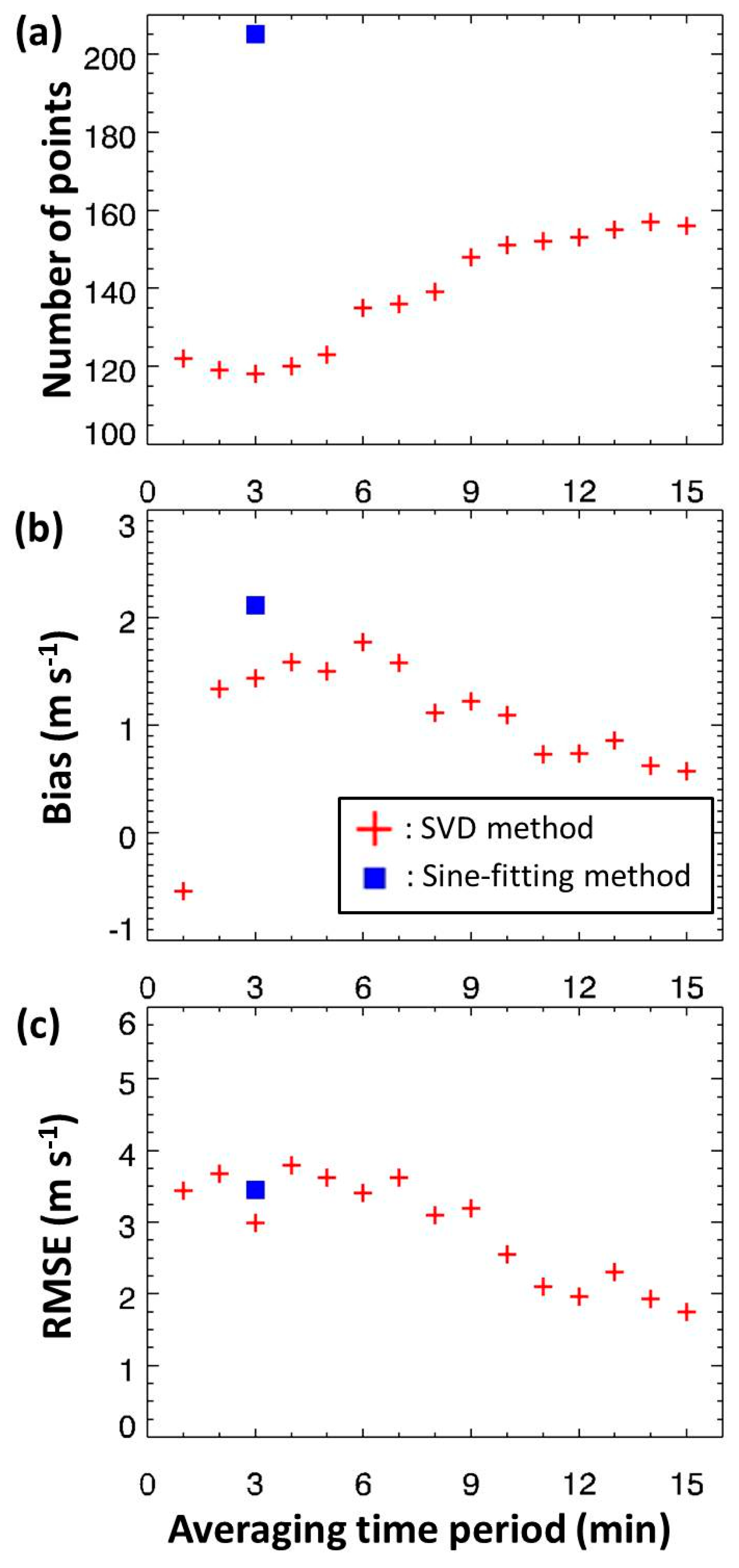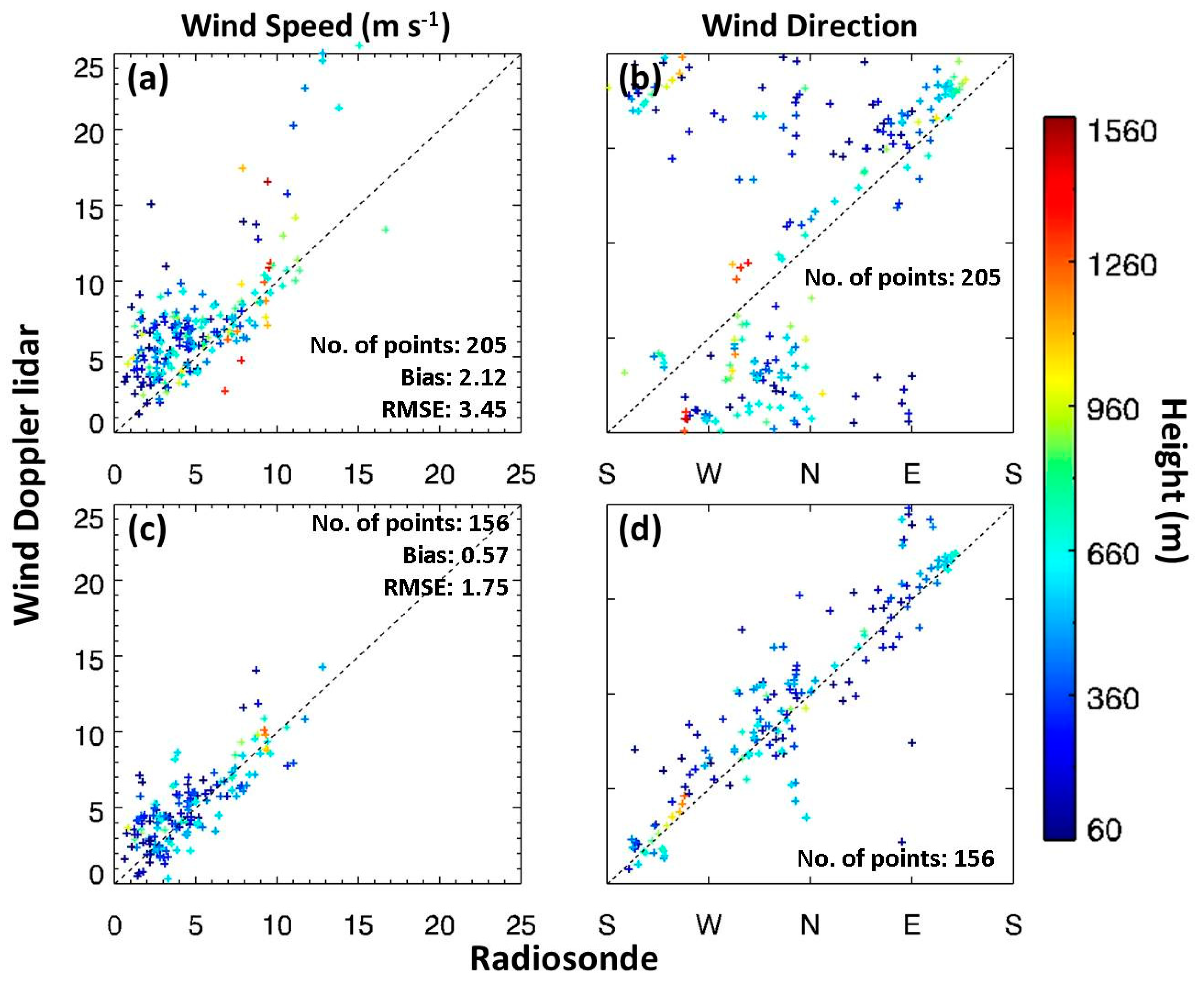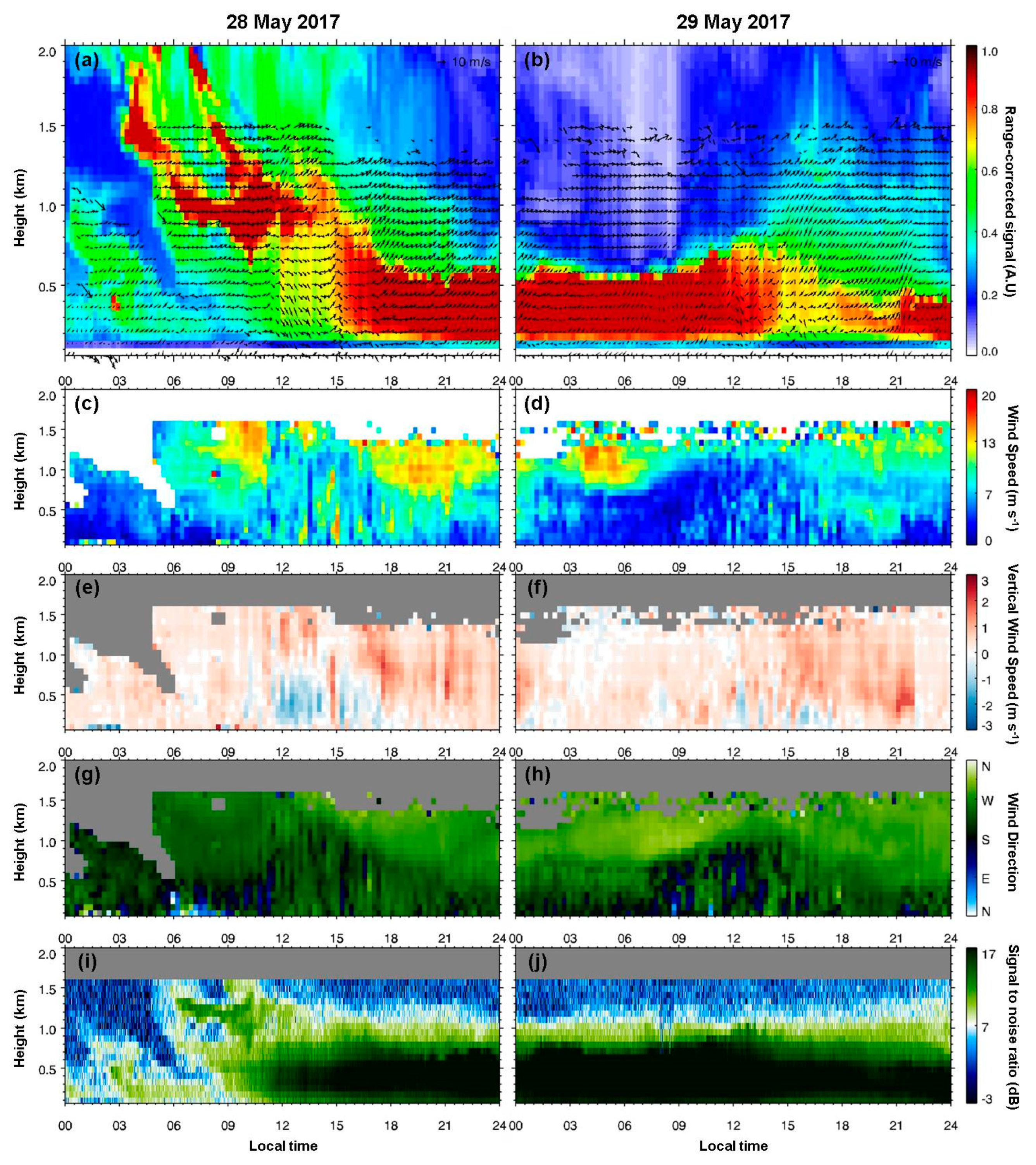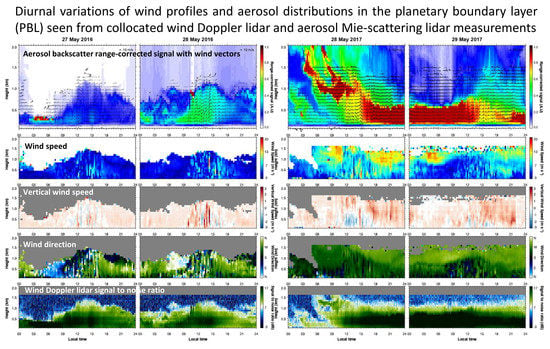3.1. Comparison of Wind Retrieval Processes
Figure 2 shows examples of comparisons of WDL wind profiles retrieved using the sine-fitting and SVD methods with those from collocated radiosonde soundings. The profiles of wind speed and wind direction by the sine-fitting method were calculated every 3 min, whereas wind profiles by the SVD method were retrieved for various time intervals to check the sensitivity of wind retrievals to the VAD scan from 1 to 15 min, as notated by different colors in
Figure 2. The wind profiles seen in
Figure 2 by both methods were averaged from 15 min after the start time of the radiosonde flight. The detection range of the WDL varied not only according to the atmospheric conditions, but also by the retrieval method. Because the distribution of aerosols within the PBL has a large variance according to atmospheric conditions (e.g., mixing height, stability, advection, diffusivity, etc.), the detection range of the WDL shows large variations from case to case. The sine-fitting method showed higher detection ranges than the SVD method, because the sine-fitting method was able to retrieve winds with a smaller number of radial velocity measurements than the SVD method. However, this may lead to higher uncertainty in the results from the sine-fitting method, especially in wind observations at higher altitudes, where the number of radial velocities used to retrieve per wind vector is smaller than that of lower altitudes. Differences in the detection range within the SVD method were also observed with variation in the averaging time interval. Wind profiles retrieved from longer averaging time intervals resulting in longer detection ranges can be attributed to the accumulation of data points at higher heights with increasing time. Variation in time-averaging intervals with the SVD method not only resulted in changes of the detection range, but also in the final retrieved wind speed and wind direction values. Wind profiles retrieved from different VAD scans of different averaging time intervals in
Figure 2 show that retrievals with longer averaging time intervals have better agreement with radiosonde soundings.
A statistical analysis was done for a comprehensive investigation of the relation between averaging time period and the wind speed/wind direction retrievals from the WDL compared with radiosonde soundings for all points from all 17 experiment data points (
Figure 3). While the sine-fitting method allowed a larger number of simultaneous data points (205) to be collected, the maximum number of wind points retrieved using the SVD method was 157 at an averaging time interval of 14 min. This coincides with the fact that the overall retrieval range of the SVD method was shorter than that of the sine-fitting method, because the latter is insensitive to a few missing points. Notably, the SVD method fails to retrieve wind vectors for VAD scans with missing values. As the averaging time interval increases, there are fewer missing points in the averaged VAD scan, resulting in higher number of simultaneous points. The bias and root-mean-square error (RMSE) between WDL measurements and radiosonde soundings showed a decreasing tendency with longer averaging time intervals, indicating that increasing the averaging time interval had a positive effect on the accuracy of the lidar wind retrievals. This can be explained by investigating the radial velocity distribution with the azimuth angle, as shown in
Figure 4. The colored points in
Figure 4 indicate the radial velocity observed at the third gate (approximately 200 m altitude) at each azimuth angle of the lidar during the 15 min after the start of the flight of the radiosonde. Each color indicates the minute during which the radial velocity was measured (i.e., initial VAD scan). Because the scanning speed of the lidar was set at 1° s
−1, for each azimuth, the radial velocity was measured during one second. Existing variances in the angular distribution of radial velocities during 15 min can lead to variances in the wind vectors retrieved depending on the used VAD. Radial velocities plotted in black are the average radial velocity at each azimuth angle (i.e., 15-min-averaged VAD scan). Comparing the initial VAD scan with the 15-min-averaged VAD scan shows a smoother plot for the latter. Because the WDL assumes horizontal homogeneity in winds, the smoother the VAD scan, the more stable the results. With a longer averaging time interval, the VAD scan is smoothed, and thus, the bias and RMSE compared with radiosonde soundings decrease. A significant improvement in the bias and RMSE can be noticed when the averaging time interval is longer than 11 min. Bias and RMSE with radiosonde soundings showed minimum values for wind profiles retrieved using the SVD method with 15-min-averaged VAD scans (0.62 m s
−1 and 1.93 m s
−1, respectively).
Considering the VAD scans in
Figure 4 to be cosine functions, the amplitudes of the VAD scans are proportional to the magnitude of wind speed. Comparing the three examples given in
Figure 4, the wind speed was strongest for 25 May 2016, the wind speed retrieved from the VAD scan of 25 May 2016 in
Figure 4 being 5.75 m s
−1. The corresponding values for the other two cases were 3.99 m s
−1 and 3.62 m s
−1, respectively. It should be noted that VAD scans can be affected not only by noise, but also by the horizontal homogeneity of winds. From the perspective of wind homogeneity, the 15-min-averaged VAD scan of 6 October 2016, showing the smallest variance in radial velocity with time, can be said to best represent the actual wind out of the three cases in
Figure 4. In other words, small variance in radial velocity distribution with time indicates a wind field with less small-scale turbulence than VAD scans showing large variance with time.
A scatterplot of radiosonde observations compared with WDL retrievals is given in
Figure 5. Although the number of points is larger when using the sine-fitting method (
Figure 5a,b), the bias and RMSE in wind speed show a large improvement (with the bias decreasing from 2.12 to 0.57 m s
−1 and the RMSE decreasing from 3.45 to 1.75 m s
−1) when using the SVD method (
Figure 5c). Moreover, it should be noted that the majority of wind vectors from higher altitudes (1 km) show large bias from the radiosonde data (
Figure 5a,b). This observation coincides with the discussion from
Figure 2, where the sine-fitting method shows lower accuracy at higher altitudes. On the other hand, horizontal drifting of the radiosonde (0.7–4.5 km horizontal drifts during a 1.5 km ascent) may also contribute to the increase of bias between the radiosonde sounding and the WDL wind profiles with height. There is a significant improvement in wind direction results when using the SVD method (
Figure 5d). Because the wind direction is calculated using the angle of the meridian (
) and zonal (
) components of wind, improvement in the wind direction can lead to the assumption that the accuracy of the retrievals of
,
, and consequently,
has undergone significant improvement.
3.2. Diurnal Variation of Winds
Diurnal variations in wind speed and direction retrieved using the SVD method on 15-min-averaged VAD scans were investigated for two cases with significantly different temporal variations in wind profiles (
Figure 6 and
Figure 7).
Figure 6 shows the daily plots of wind speed and direction on 27 (left panel) and 28 (right panel) May 2016, observed at the Gwanak site, during which time the wind profiles displayed characteristics close to a convective boundary layer, showing large variation in wind speed and direction between day and night as a result of the thermal heating of the surface [
19]. Wind speeds were low during the night (2.28 m s
−1) and higher wind speeds were observed during the daytime (10:00–17:00 local time; 3.58 m s
−1). Vertical wind speed also showed similar diurnal variation. However, during the afternoon, rapid changes between updrafts and downdrafts were observed (the vertical wind speed variation of 0.32 m
2 s
−2 during the day was significantly larger than that during the night (0.06 m
2 s
−2)), implying that turbulence of the boundary layer was thermally induced. While a consistent weak updraft was observed apart from the turbulent hours, strong updrafts were observed during the afternoon of 28 May 2016. This strong updraft coincided with the sudden thickening of the aerosol layer, leading to the inference that convection played an important role in the transportation of aerosols to higher altitudes (i.e., vertical mixing of aerosols in the PBL).
Meanwhile, the change in the diurnal wind direction during 27–28 May 2016 showed the typical pattern of valley and mountain breezes. Due to the inhomogeneity in surface heating, valley winds blew during the day. As shown in
Figure 1, the Gwanak observational site was situated on the northward slope of Mt. Gwanak (632 m above the mean sea level), and thus, the valley winds are northeasterly winds. During the night, mountain (i.e., southwesterly) winds were observed.
Diurnal variation in the WDL detection range, with shorter detection limits during the night and early morning, and maximum ranges during the afternoon, was noted. Combining this observation with a collocated aerosol Mie-scattering lidar, we could see that the evolution of the thickness of the aerosol layer near the surface matched the variation in maximum observation range of the WDL (
Figure 6a,b). As previously mentioned, the signal-to-noise ratio (SNR) of the WDL was especially sensitive to the aerosol loading in the atmosphere. As shown in
Figure 6i,j, the SNR typically decreases with height. However, the existence of an aerosol layer aloft (as was the case close to midnight on 28 May 2016) was accompanied by a higher SNR. Note that the value of 7 dB is specially indicated in white to notify the WDL observation limit set by the manufacturer.
Figure 7 shows the profiles of wind speed and direction from 28–29 May 2017, which differs from
Figure 6 in temporal variation. Winds were more influenced by the synoptic weather pattern than thermally induced convection. Wind shear was clearly observed during this period, and westerlies were consistent throughout the whole period. Wind speed did not show drastic changes throughout the day, as evidenced by the average wind speed of 7.59 ± 3.07 m s
−1 between 10:00 and 20:00 local time and 7.11 ± 3.55 m s
−1 during the rest of the day. This observation differs greatly from the temporal variation of wind speed in the case in
Figure 6. Unlike in
Figure 6, the WDL detection range did not show a large temporal variation, especially during 29 May 2017, and the WDL provided close-to-consistent observations up to its maximum detection range during the entire day. This was possible due to a thick aerosol layer that was advected from around 1.5 km at 5:00 local time down to the surface (
Figure 7a). A downdraft observed at noon on 28 May 2017 coincided with the sudden downward entrainment of the aerosol layer, gradually increasing the aerosol loading at the near surface (
Figure S1). On the other hand, a slight reduction in surface aerosol concentration was induced by the strong updrafts at 15:00 local time on 29 May 2017. However, it is difficult to conclude that downdrafts result in aerosol entrainment to the surface and updrafts in diffusion, because even for the days given in
Figure 7, the relationship between vertical wind and aerosol movement is not consistent. Further studies with more observation data are needed for a comprehensive understanding of the mechanism between aerosol advection and winds within the PBL.

